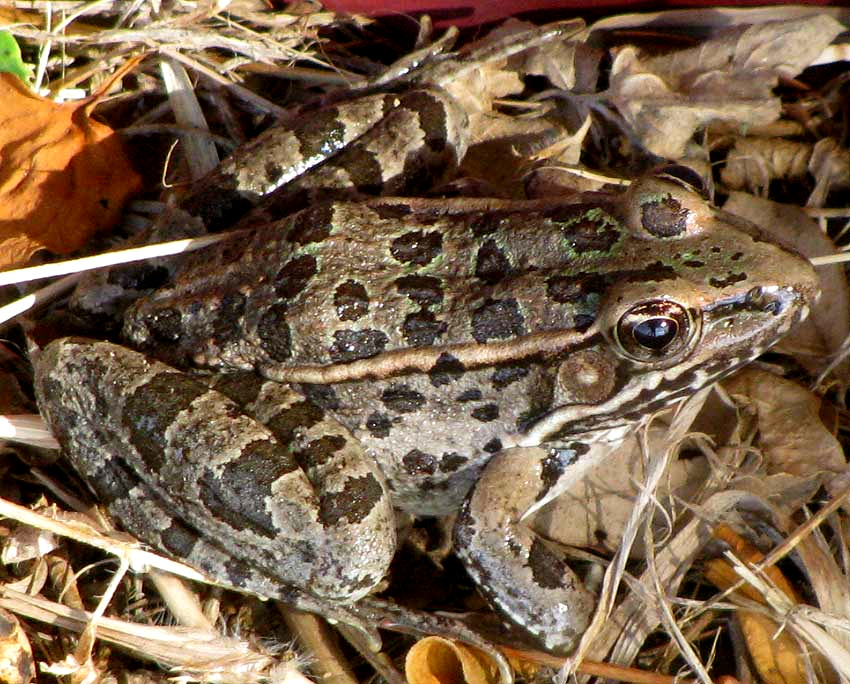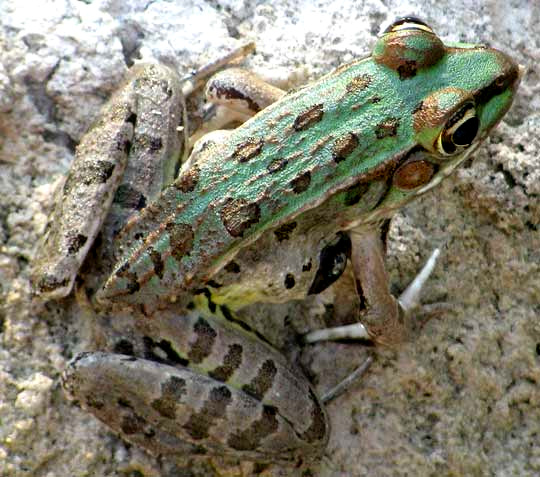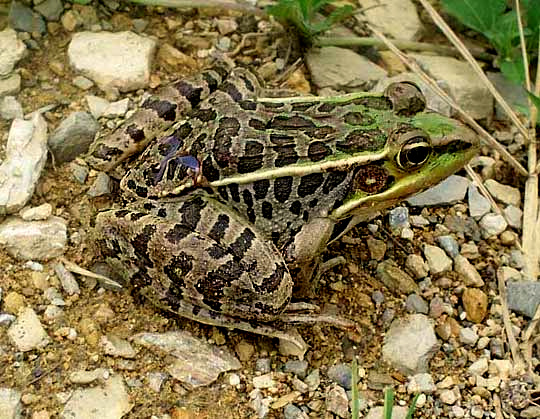Excerpts from Jim Conrad's
Naturalist Newsletter

from the September 2, 2012 Issued from the valley of the Dry Frio River in northern Uvalde County, southwestern Texas, on the southern border of the Edwards Plateau; elevation ~1750m (~5750 ft); N29.62°, W99.86°; USA
RIO GRANDE LEOPARD FROGS
While pulling weeds from flower beds around the cabin I upset a couple of fair-sized frogs, causing them to jump into the open. Above, that's one a split second before he jumped for cover.
He's a leopard frog, which you can tell because of the heavy blotching and the pair of conspicuous, raised lines, or "dorsolateral ridges," running down the back. However, several leopard frog species are recognized, and there's much variation within some of the species, so here was my first amphibian challenge since arriving here.
I guessed that they were Southern Leopard Frogs like back in Mississippi. However, distribution maps for that species show that it doesn't occur this far west. The "List of Amphibians of Texas" at https://en.wikipedia.org/wiki/List_of_amphibians_of_Texas lists eight species of "true frogs" -- members of the genus Rana -- for Texas, and when I refer to the distribution maps for those eight species, only one is found this far southwest.
And that's the Rio Grande Leopard Frog, RANA BERLANDIERI*, said to be distributed from south-central and western Texas south through eastern Mexico into Nicaragua, with an island population in southwestern Arizona and a tiny part of adjacent California. I say "said to be distributed" because they occur in such different habitats that it's hard to believe they're all the same species, and the experts admit that the tropical part of the population is poorly studied. I read that at the reservoir at the rainforest ruin of Tikal in northern Guatemala frogs going by this name are very common, and Tikal's environment is a far cry from what we have here.
The Dry Frio River runs maybe 200 yards (200m) behind the cabin, so that explains what a leopard frog is doing in this arid area. I read that their calls resemble a fast-paced chuckle, like an excited duck quacking, so there's something to look forward to on my first rainy night here. Rio Grande Leopard Frogs are described as fairly common throughout their distribution area.
from the September 8, 2013 Newsletter issued from the valley of the Dry Frio River in northern Uvalde County, southwestern Texas, on the southern border of the Edwards Plateau; elevation ~1750m (~5750 ft); N29.62°, W99.86°; USA
GREEN LEOPARD FROG
The frog shown above is a light brown color. However, a younger member of the same species seen this week at a drying-up pool in the Dry Frio was largely green, as you can see below:

The Herps of Texas website describes the "dorsal color" as either pale brown or green, so this is no surprise. From a distance the brown and green ones do look very different, but the spotting and other features are all the same.
from the August 12007 Newsletter issued from Sierra Gorda Biosphere Resere, Querétaro, MÉXICO
A LEOPARD FROG IN QUERÉTARO
Passing by a pond emerald green with algae, a leopard frog was spotted a few feet from the bank. On my hikes typically critters fly or jump away before I can unstrap my backpack, bring out the camera and wait for it to hum and click before it can take a picture but this time I did all that and the frog still sat there. I took pictures closer and closer until he filled my entire viewer. You can see the resulting portrait below:

Who knows why this frog didn't jump? He did when he was prodded. Maybe he was a philosopher frog. Anyway, he looks pretty much like the US's Northern Leopard Frogs, except that his body is grayer than I'm used to.
Back at the computer I was shocked to see that leopard frogs have been shifted from the nice genus Rana to the harder-to-remember Lithobates.
Moreover, leopard frog taxonomy is poorly understood, so we'll just call this a leopard frog, genus Lithobates.